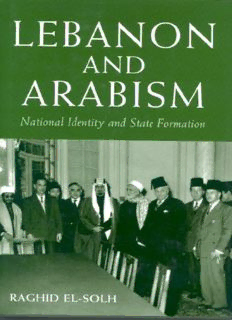
Lebanon and Arabism, 1936–1945 PDF
Preview Lebanon and Arabism, 1936–1945
LEBANON AND ARABISM Lebanon and Arabism: National Identity and State Formation Raghid El-Solh I.B.Tauris Publishers LONDON • NEW YORK in association with Centre for Lebanese Studies Published in 2004 by The Centre for Lebanese Studies, Oxford in association with I.B.Tauris & Co Ltd 6 Salem Road, Bayswater, London W2 4BU 175 Fifth Avenue, New York NY10010 Website: http://www.ibtauris.com In the United States and Canada distributed by St Martin’s Press 175 Fifth Avenue, New York NY 10010 Copyright © Raghid El-Solh and The Centre for Lebanese Studies, 2004 All rights reserved. Except for brief quotations in a review, this book, or any part thereof, may not be reproduced, stored in or introduced into a retrieval system, or transmitted, in any form or by any means, electronic, mechanical, photocopying, recording or otherwise, without the prior written permission of the publisher. ISBN 1 86064 051 6 A full CIP record for this book is available from the British Library A full CIP record for this book is available from the Library of Congress Library of Congress Catalog card: available Typeset in BerkeleyOldstyle by Oxford Publishing Services Printed and bound in Great Britain by Biddels Ltd, Guildford and King’s Lynn My parents provided the inspiration for my interest in Lebanon and the Arab world. A good part of the political experience of my late father, Kazem El-Solh, was recorded in a private paper collection that has provided additional insight into the subject matter at hand. My mother, Yesr El-Solh, provided me with a wealth of anecdotes about Lebanese politics. This book is dedicated to both of them. Contents Preface ix Acknowledgements xi Note on Transliteration xiii List of Frequently Used Abbreviations xv Introduction 1 1. The Treaties with France and their Implications for Syria and Lebanon 11 2. The Years of the Treaty System 59 3. The Outbreak of the Second World War and the Dismantling of the Treaty System 99 4. The Anglo-French Condominium 139 5. Independent Lebanon and the Bilateral Talks on Arab Unity 185 6. Greater Lebanon and the League of Arab States 241 Conclusion 287 Epilogue 293 Bibliography 359 Index 367 vii Preface This book was originally a thesis submitted in 1986 in fulfilment of the requirements for the Degree of Doctor of Philosophy in the Faculty of Social Studies, University of Oxford. The thesis was researched and written while Lebanon was plunged into war. By all accounts, the war was related to the differences among the Lebanese regarding the subject of Lebanon’s national identity. These differences had been a dominant factor of Lebanese politics since the emergence of the Lebanese state. Their intensity militated against Lebanon’s independence from foreign powers and the development of parliamentary democracy in the country, and threatened the social and political fabric of Lebanese society. However, by the mid-1930s, due to international, regional and local developments, the divergences nar- rowed down and a process of national reconciliation began to emerge, culminating in the Lebanese National Pact in 1943. The book con- centrates on this process, starting in 1936 and ending in 1945, that is, when the Lebanese seemed to have arrived at a formula to reconcile Lebanese with Arab nationalism. This formula, incorporated within the Lebanese National Pact, enabled Lebanon to achieve independence from France and to be an important player in founding the Arab regional system. The 1943 National Pact formula was challenged repeatedly during the post-Second World War period. These challenges peaked towards the late 1980s, culminating with the Ta’if Agreement in 1989. New formulae and approaches were suggested to resolve the differences between the Lebanese and Arab nationalists. This book attempts to provide students of Lebanese politics with the opportunity to reflect on and explore the ix
Description: